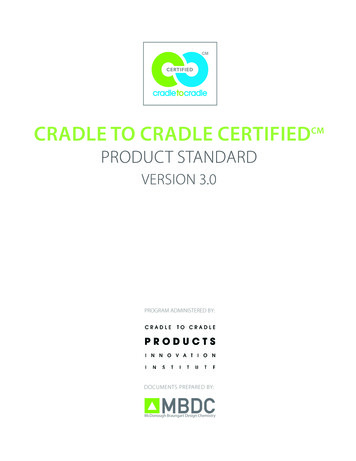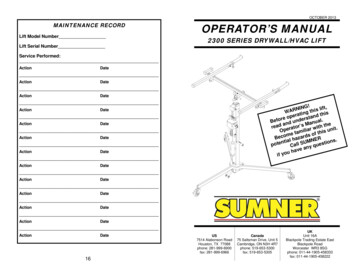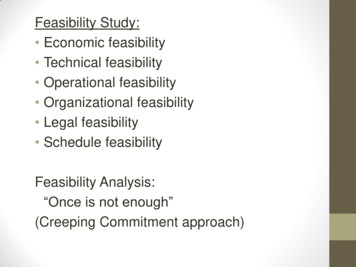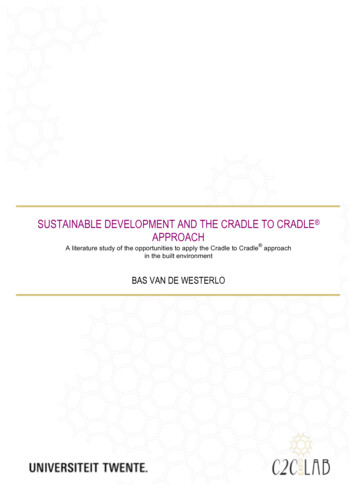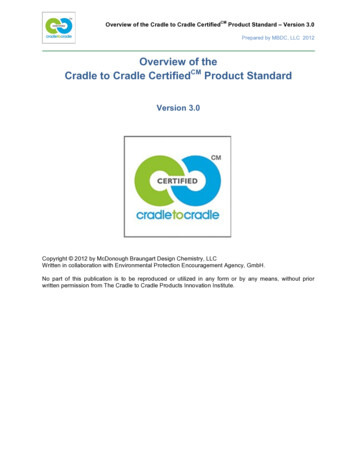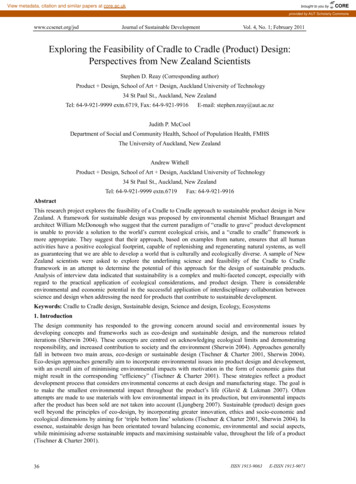
Transcription
View metadata, citation and similar papers at core.ac.ukbrought to you byCOREprovided by AUT Scholarly Commonswww.ccsenet.org/jsdJournal of Sustainable DevelopmentVol. 4, No. 1; February 2011Exploring the Feasibility of Cradle to Cradle (Product) Design:Perspectives from New Zealand ScientistsStephen D. Reay (Corresponding author)Product Design, School of Art Design, Auckland University of Technology34 St Paul St., Auckland, New ZealandTel: 64-9-921-9999 extn.6719, Fax: 64-9-921-9916E-mail: stephen.reay@aut.ac.nzJudith P. McCoolDepartment of Social and Community Health, School of Population Health, FMHSThe University of Auckland, New ZealandAndrew WithellProduct Design, School of Art Design, Auckland University of Technology34 St Paul St., Auckland, New ZealandTel: 64-9-921-9999 extn.6719Fax: 64-9-921-9916AbstractThis research project explores the feasibility of a Cradle to Cradle approach to sustainable product design in NewZealand. A framework for sustainable design was proposed by environmental chemist Michael Braungart andarchitect William McDonough who suggest that the current paradigm of “cradle to grave” product developmentis unable to provide a solution to the world’s current ecological crisis, and a “cradle to cradle” framework ismore appropriate. They suggest that their approach, based on examples from nature, ensures that all humanactivities have a positive ecological footprint, capable of replenishing and regenerating natural systems, as wellas guaranteeing that we are able to develop a world that is culturally and ecologically diverse. A sample of NewZealand scientists were asked to explore the underlining science and feasibility of the Cradle to Cradleframework in an attempt to determine the potential of this approach for the design of sustainable products.Analysis of interview data indicated that sustainability is a complex and multi-faceted concept, especially withregard to the practical application of ecological considerations, and product design. There is considerableenvironmental and economic potential in the successful application of interdisciplinary collaboration betweenscience and design when addressing the need for products that contribute to sustainable development.Keywords: Cradle to Cradle design, Sustainable design, Science and design, Ecology, Ecosystems1. IntroductionThe design community has responded to the growing concern around social and environmental issues bydeveloping concepts and frameworks such as eco-design and sustainable design, and the numerous relatediterations (Sherwin 2004). These concepts are centred on acknowledging ecological limits and demonstratingresponsibility, and increased contribution to society and the environment (Sherwin 2004). Approaches generallyfall in between two main areas, eco-design or sustainable design (Tischner & Charter 2001, Sherwin 2004).Eco-design approaches generally aim to incorporate environmental issues into product design and development,with an overall aim of minimising environmental impacts with motivation in the form of economic gains thatmight result in the corresponding “efficiency” (Tischner & Charter 2001). These strategies reflect a productdevelopment process that considers environmental concerns at each design and manufacturing stage. The goal isto make the smallest environmental impact throughout the product’s life (Glavič & Lukman 2007). Oftenattempts are made to use materials with low environmental impact in its production, but environmental impactsafter the product has been sold are not taken into account (Ljungberg 2007). Sustainable (product) design goeswell beyond the principles of eco-design, by incorporating greater innovation, ethics and socio-economic andecological dimensions by aiming for ‘triple bottom line’ solutions (Tischner & Charter 2001, Sherwin 2004). Inessence, sustainable design has been orientated toward balancing economic, environmental and social aspects,while minimising adverse sustainable impacts and maximising sustainable value, throughout the life of a product(Tischner & Charter 2001).36ISSN 1913-9063E-ISSN 1913-9071
www.ccsenet.org/jsdJournal of Sustainable DevelopmentVol. 4, No. 1; February 2011Sustainable product design is a relatively new discipline in that it positions sustainability (in itself complex andmultifaceted) at the heart of every product designed (Fiksel 2001). The concept of sustainability is complex,dynamic, and often nuanced by the context in which is placed (i.e. sustainable forestry, sustainable development,etc.) (Walker 1998, Walker & Dorsa 2001). In an era that has been charged with the task of addressing issuesaround climate change and environmental degradation, no other period has imposed the same critical attention tothe environmental and social costs of product production and use. This is a new era where environmentalismtakes place alongside (but not yet contesting) the discourse of economics. Now more than ever, the role ofproducts and services is central to the sustainability debate. There are significant benefits for those who are ableto identify opportunities to develop sustainable products and services (Tischner & Charter 2001). Morespecifically, these opportunities will be realised by designers who develop radical innovative solutions byinvolving sustainability at the early stages of the design process (Sherwin 2004).1.1 Cradle to CradleMcDonough and Braungart (2002) and Braungart et al. (2007) describe the “Cradle to Cradle” approach as “thenext industrial revolution” and suggest that industry needs a new paradigm that effectively and seamlesslyaddresses issues associated with over-consumption and waste. Central to Cradle to Cradle is the critique of theuse of “eco-efficiency” as a driver for developing environmentally benign products and systems. They argue theultimate goal of eco-efficiency, zero emission, which aims for maximum economic output with zeroenvironmental impacts, is the ultimate endpoint of such an approach and represents a breakdown of theeconomic and ecological relationship. The authors solution to sustainable development- eco-effectiveness, aimsto generate cyclical Cradle to Cradle metabolisms to maintain the status of resources (Braungart et al. 2007). Theeco-effective approach starts with a vision that industry is 100 percent good, the concept of waste does not exist(as all outputs from one process become inputs for another), supports and regenerates ecological systems andenables long-term prosperity and is the basis for “triple top line” objectives (Braungart et al. 2007). The Cradleto Cradle framework attempts to turns materials into nutrients by enabling their perpetual flow within eitherbiological or technical metabolisms. In this scenario, biodegradable materials (biological nutrients) are absorbedback into, and have a positive impact on the environment. Synthetic or mineral materials (technical nutrients)remain safely in a closed loop system of manufacture, recovery and reuse to maintain their material valuethrough many cycles, and are owned by manufacturers, but are used by consumers as products of service(Braungart et al. 2007). In eco-effective industrial systems waste becomes biological nutrients for ecologicalsystems, and are therefore ecologically irrelevant to be included into a saleable product (Braungart et al. 2007).The authors suggest that even if enormous amount of waste were generated in production, the system as a wholewould become eco-effective, as waste is a productive resource for natural systems.This study aims to evaluate the application of the Cradle to Cradle design framework from an ecologicalperspective, in an attempt to determine the feasibility of this approach, for the design of products. A deeperexploration of the Cradle to Cradle design framework is a relevant reference point to reflect where designthinking might currently be, and is a sound basis for initiating a sustainability discussion.2. MethodsA series of key informant interviews was undertaken with New Zealand scientists to explore expert opinion onthe feasibility and issues associated with the Cradle to Cradle framework and sustainable design approaches ingeneral. The purpose of conducting key informant interviews was to generate a broad understanding of the keyissues, barriers, and opportunities from those who have specific scientific expertise. The Cradle to Cradleframework relies primarily on a fundamental understanding of materials, science, systems and processes. Asemi-structured interview format was utilised to guide the interview, to allow differing ideas to surface and forreflective discussion. A thematic analysis of the data was conducted and an explanatory theory based on theemerging themes was subsequently developed. Key informant interviews are an important qualitative researchmethod in terms of providing insight into issues that cannot often be identified through other research methods(e.g. focus group interviews or questionnaires).2.1 ParticipantsKey informant participants were chosen using a non-probability purposive sampling technique, and selectedbased on their unique experience in a particular scientific field. The scientists selected were chosen from a rangeof scientific disciplines related to the primary industries in New Zealand. This group were chosen because theyhave a broad understanding of the biological processes that underpin sustainability, or the development ofmaterials and processes that may be required for the development of sustainable systems. Each scientist selectedwas employed in a senior science position in either a Crown Research Institute or New Zealand University.Published by Canadian Center of Science and Education37
www.ccsenet.org/jsdJournal of Sustainable DevelopmentVol. 4, No. 1; February 2011Contact details were obtained from information in the public domain.Potential participants were contacted by an email informing them about the study aims and rationale and invitingtheir participation. If no response was received following the email invitation to participate, this was taken tomean the individual declined to take part in the study, and no further contact was initiated.Participants that took part in the study were from the following areas of expertise: biology, materialscience/engineering, biotechnology, science strategy, chemical and process science/engineering, pharmacologyand active agent science, microbiology, and textiles science.2.2 ProcedurePrior to the commencing of the interview process, approval to carry out the study was sought and obtained fromthe Auckland University of Technology Ethics Committee (AUTEC Reference Number 09/54).Participants were invited to take part in a key informant interview to discuss a range of topics centred onsustainability and Cradle to Cradle design. Participants were provided with an abbreviated version of the Cradleto Cradle framework (Braungart et al. 2007) and it was from this basis that the interviews were conducted. Theinterviews were based around a series of open-ended questions (described below) and enabled the participants toexplore the questions in-depth.Key informant interview themes/questions1)What is the role of sustainability in the context of your science field?2)What materials are important/critical to achieve sustainable products?3)What do you understand about the concept of Cradle to Cradle as a proposition for sustainability withrespect to science/design?a) What were your first impressions with respect to the principles that underpin the concept?b) What is the potential of this concept for New Zealand science/technology?c) What is the role of science to help facilitate a Cradle to Cradle framework?d) Can New Zealand embrace this concept, and what do you see as potential barriers/opportunities?4)How do you view the role of scientists/science in adopting a concept like Cradle to Cradle?New questions were included to reflect emerging issues as interviews progressed. Interviews were audiorecorded to enable transcripts to be used for analysis. Detailed field notes were also taken during the interviews,where possible, to complement the transcripts. Interviews were conducted by SR, took no longer than one hour,and were conducted in the participants’ workplace at a time that was convenient for them.The interviews were analysed using a qualitative thematic analysis method whereby the textual data was readand coded to identify common and divergent viewpoints (Berg 1998). The key perspectives or themes weredeveloped in consultation with co-authors and when agreement was reached, they were then developed into anexplanatory model. All possible attempts were made to obscure the contribution of participants to protect theiridentities, including their place of employment, age and gender.3. ResultsResults from the textual analysis of the interview data are presented according to the key (dominant) themes.Descriptive statistics are presented to show the number of participants who described a similar viewpoint ortheme (Table 1). Direct quotations are presented to illustrate a pervasive or idiosyncratic perspective. The themeswill be presented in respective order: informants’ general impressions of the Cradle to Cradle design framework;a critique of the Cradle to Cradle design framework; barriers preventing sustainable design frameworks frombeing broadly implemented and opportunities for sustainable design in New Zealand. Finally, this sectionconcludes with the emergent themes around the future of sustainable design in the context of New Zealand, andthe potential role of science and technology.3.1 General impressions of the Cradle to Cradle design frameworkMost participants had not heard of the Braungart et al. (2007) Cradle to Cradle design framework prior toparticipating in this study. All participants expressed a diverse range of perspectives on the general concepts andrationale behind the Cradle to Cradle framework. In general, participants agreed that the general principles thatunderpin Cradle to Cradle are important factors when attempting to address sustainability.“It’s an interesting concept You know so it sounds like the sensible way to go to me ” (Materials38ISSN 1913-9063E-ISSN 1913-9071
www.ccsenet.org/jsdJournal of Sustainable DevelopmentVol. 4, No. 1; February 2011Engineer/Scientist)Participants supported Braungart et al. (2007)’s interpretation of the tension between economic growth andenvironmental objectives. Specifically, the concept of “eco-efficiency” as a strategy to resolve issues aroundresource use and provide a sustainable future was viewed as “accurate”. Although participants were generallyfavourable toward the rationale for Cradle to Cradle the majority considered it to be idealistic: a good idea inprinciple, but not in practice. Overall, it was it was not widely accepted as a mechanism that would reflect therealities of complex social and environmental ecosystems.“I felt the general scope was idealistic. Not to say that it’s bad. Just that I wouldn’t want to totally adhere to it”(Biotechnologist)“I think the model’s been well thought through but I worry that they tried to apply it in ways that perhaps itdoesn’t comfortably fit” (Chemical and Process Engineer/Scientist)There was not a clear consensus as to whether Cradle to Cradle was an appropriate approach to use as a principalfor product design. One participant felt that it had merit on a product-to-product basis, but that moving to societylevel sustainability was an entirely different proposition. Another suggested that it was an appropriate approach,but questioned whether “it was the only approach”. Another believed it did not add anything new. Throughoutthe interviews, the participants agreed that greater effort is required to develop modes of living, and products toassist healthy productive lives that also support future generations.3.2 Can we have a positive impact?The majority of participants viewed the goals of reducing human impacts to zero as a more realistic goal thanattempting to produce positive impacts on the environment.“Your impact on the environment, you can’t absolutely reduce it to zero everything we do [has] anenvironmental impact and I think what, the aim of this paper I mean, might be zero waste but I think, butthere’s always going to be this inefficiency somewhere in the system that requires some leakage, you can’t have I don’t think you can have a perfect system” (Biologist)Participants were generally in consensus around the issue that to have a positive impact we must know what thatpositive might be. They argued that this may not always be the case, and some added that even if it was, wemight not have the capability to measure such impacts.“Because suggesting you actually know what’s positive for the environment we don’t seem to have a handle onthe complexities of how things interrelate to know precisely what the outcomes will be, so I think it sounds a verystrange thing to think that we can do things for the positive to be honest So I think I’m still a fan of doing aslittle damage as possible” (Materials Engineer/Scientist)“ some of these things you can probably never measure Do we have to measure anything just to get a sensethat we would be better off doing it one way rather than another way I don’t think we do” (Microbiologist)Four participants discussed the complexity around deciding what is natural (and therefore what is “good” for theenvironment), and observed looking to nature for inspiration may not always be appropriate. Reasons included adescription of nature as being very complex, and a failure to recognise this when “fixing” one thing may cause aproblem elsewhere. The overwhelming consensus was that regardless of whether a positive impact on theenvironment was possible or not, it was important to minimise impacts as much as possible in the short tomedium term.3.3 Is waste always good?While the ideas of biological and technical nutrient cycles were generally viewed as being interesting, someparticipants argued that these approaches might not always be possible, or practical. As anticipated, someparticipants agreed in principle with the concept of biological nutrient cycles. However the majority cautionedthe risks of extrapolating a theoretical principle to real world situations. In particular, participants question thepotentially enormous quantities of biological nutrients that might be produced, and questioned how this ‘natural’waste would be managed, especially as high levels of nutrient inputs can have detrimental impacts on ecologicalsystems. One participant described that the transition from a largely inorganic system to an organic system wouldbe required to fulfil Cradle to Cradle requirements. While this in itself was viewed positively, most productscurrently produced are not made from organic-based materials. The result of this could be large quantities oforganic “waste” material. One participant observed this was “fine when things are in village amounts, but withcity amounts you get problems”.Three participants suggested that knowing where to put the biological nutrients and knowing what influence theyPublished by Canadian Center of Science and Education39
www.ccsenet.org/jsdJournal of Sustainable DevelopmentVol. 4, No. 1; February 2011may have on a system was an issue.“ put it in an environment where its waste can be utilised, not just thrown in an inappropriate place is allwaste good?, it depends upon how it is going to be utilised” (Biotechnologist)The application of something as simple as a fertiliser was described as having a significant impact on anecosystem, especially with regard to soil micro-organisms, reflecting the complexity surrounding inputs intonatural systems.“ Well, you put that fertilizer on for a reason and you want it to actually renew a system the microbes willrespond in a certain way. Some of them will love it, some of them will hate it and you will change the makeup ofthe soil It’s not necessarily good or bad, but its changed But what’s happened in the soil, is that sustainable?”(Science Strategist)Energy and time were considered important when addressing the principal of “biological nutrients”. Oneparticipant suggested that long term thinking (“a time bound”) was required to transition from product tobiological nutrient, and even longer for the biological nutrient to become the “next organic”. Furthermore“there’s an energy input is really part of the equation”, and “you’ve got to assume for some of this that energy islow cost.”One participant suggested that the controlled composting of biological waste material was important, as“uncontrolled composting is not efficient, and doesn’t always produce a usable bio-product”.While many of the participants found the idea of a technical nutrient cycle appealing, six of the eight participantsthought the degradation of materials in this cycle wasn’t fully addressed in the Cradle to Cradle framework.Comments ranged from not illustrating that the material integrity of synthetic materials degrades with use, andrepeated reuse, to suggestions that all materials wear out during use.“ so I don’t think it’s appropriate to just think in an idealistic fashion that materials can be recycled adinfinitum.” (Biotechnologist)“ it’s not perhaps a loop, more of a very slow downward spiral” (Textiles Scientist)Furthermore metals (as potential technical nutrients) were described as oxidising and wearing out. While it wassuggested that processes such as oxidisation might be reversed, this takes considerable energy inputs.3.4 What do we need to consider when using a new design framework?One of the common themes that emerged during the analysis was the complexity involved with issues aroundsustainability.“ they’re not simple issues. It’s a complex system. And that’s what you’re talking about here. Sustainability is acomplex system ” (Science Strategist)Access to clean renewable energy sources was described as being an important aspect of the future ofsustainability. Energy, as we currently use it, was described by one of the participants as being the only part of aclosed system that disappears due to entropy. They suggested that unlike nature, which has endless energy fromthe sun, we need energy to create energy.The majority of participants described the development of better eco-effective or eco friendly materials as beinginfluenced by a variety of factors.“ what’s the rate limiting step, and it’s typically creative people and funding and the identifying need. Creativepeople on their own without an identified need, aren’t going to create what’s useful. Needs can be stated, but youneed people to make it.” (Biotechnologist)It was suggested by one participant that the manufacture of biological-based materials depended on very largequantities of plant materials. Research into base materials and technological challenges associated with usingnew materials (during manufacture) were examples given by another participant of some of the researchchallenges. For some base materials, these were not considered to be significant hurdles, but for others it wasdescribed as very difficult. The lack of performance by some organic-based materials in comparison with theirsynthetic counterparts was considered a hurdle in terms of the wider acceptance of organic materials.3.5 How might science play a role in the design of sustainable products and services?Participants were generally in agreement with regard to the role that science might play around issues ofsustainability. Some participants favoured looking to natural systems for ways of living more sustainably, or fordeveloping and utilising sustainable materials. One participant suggested that sustainability “ will come from40ISSN 1913-9063E-ISSN 1913-9071
www.ccsenet.org/jsdJournal of Sustainable DevelopmentVol. 4, No. 1; February 2011mimicking nature or fitting into nature’s cycles.” Another participant suggested we look more to organicmaterials, and continue research into new ways in which they might be used. It was also suggested we need tolook at “old” (organic) materials and to develop new manufacturing processes so we can use them moreeffectively and efficiently.Other participants described the role of scientists as helping to negotiate the complexity of systems.Understanding what aspects of systems and processes we need to measure, and how to measure them, weredescribed as being fundamental, for now and into the future. One participant described science measurement asbeing short term, or at a single point in time, and suggested that measuring positive impacts would therefore besimilarly constrained.A key role of science will be helping to develop solutions, as well as identifying the associated risks. Sciencewas described as a vital process for learning and understanding sustainability problems and solutions (“doing thethinking”). Science was described as “fast moving” and that lack of knowledge should not be barrier, as ithistorically it might have been. This was also described as being true for issues centred on sustainability.Five participants described the role of biotechnology, including techniques such as genetic modification, as beingessential to maintaining the current human population. One participant suggested that those countries that arephilosophically opposed to technologies such as GE will have difficulty addressing issues of sustainability,especially if their populations are growing. Another participant suggested that scientists needed to better describethe benefits of these technologies, and how they will have to be used wisely.One participant described science as the first step in the process of developing new materials and technologies.New technologies will not be developed in the absence of good science. Beyond that, industry needs to “buy in”to fully realise the opportunities that new technologies offer. This participant described the “dream” as the firstpart of the process. Science is required to make this happen, so business and consumers may then follow.4. DiscussionIn general, the majority of participants were involved in research where issues of sustainability, if not central to it,represented a considerable aspect of their research, or they had an interest in general issues surroundingsustainable futures. Overall participants responded positively to the intent of the Cradle to Cradle framework.A dominant theme that emerged from the interviews was the complexity associated with understanding theinteractions of humans, societies and their environments. To address issues of sustainability with rigour requiresan ability to explore and work within complex systems and demands (Bradbury 2002, van Roon & Knight 2004).The domain of a scientist is to understand interactions between multiple factors (see Bradbury 2002). Thisrequires the capacity to ask questions framed in an appropriate context and the aptitude to interpret and discusscomplex results. The key informant interviews illustrate that consideration of human impacts on the environmentis critical, and was the most discussed factor when referring to sustainability. While issues of social sustainabilityand economic sustainability were mentioned they were not regarded with the same level of consideration. Fromthe participants’ perspective, the environment was considered the foundation of sustainability. Therefore theprotection of biodiversity and the natural systems in which it persists is fundamental to fulfil the principles ofsustainable development. While “Our Common Future” describes this as “meeting the needs of the presentgeneration without compromising the ability of future generations to meet their own needs” (WCED1987, p49),van Roon and Knight (2004) describe this definition as the balanced approach whereby ecological needs areweighed against economic and social. They suggest that while this approach is commonly acceptedinternationally, it represents a framework for weak sustainability. The results from this study support the use of aframework for strong, or ecological sustainability, where decision-making is made within an ecological context(Ekins et al. 2003, van Roon & Knight 2004). This approach recognises that humans are part of ecologicalsystems, and viewing human activities as being separate from nature will ultimately be unsuccessful.Furthermore, van Roon and Knight (2004) argue that the functional capability of ecosystems need to be centralto decision making processes.A few barriers to implementing some principles of the Cradle to Cradle framework were raised by theparticipants. These were around the concepts of technical and biological nutrients, the interpretation of nature (orwhat is natural), and energy use and generation. Some participants questioned whether technical nutrients weresuitable for “closed loop” systems. They suggested that the material integrity of synthetics and metals is notalways easily maintained. Participants also acknowledged the role of consumerism in helping to create orencourage unsustainable practices, as well as the failure of consumers to pay the “true environmental cost” ofthis behaviour. Neither of these are fully acknowledged and addressed by Braungart et al. (2007).Published by Canadian Center of Science and Education41
www.ccsenet.org/jsdJournal of Sustainable DevelopmentVol. 4, No. 1; February 2011The participants in this study expressed a need for caution when approaching the concept of biological nutrientsas a simple solution to sustainability problems. The inherent complexities of ecological systems are confoundedfurther by difficulties around measurement. This situation is further complicated when interactive (i.e. history,age, productivity, habitat heterogeneity and complexity etc.) and intimate (i.e. succession, inter-specificinteractions, disturbance, dispersal etc.) factors are added (Jeffries 2006).Reijnders (2008) criticizes the concept of biological nutrients as “healthy wastes”. Firstl
McDonough and Braungart (2002) and Braungart et al. (2007) describe the "Cradle to Cradle" approach as "the next industrial revolution" and suggest that industry needs a new paradigm that effectively and seamlessly addresses issues associated with over-consumption and waste. Central to Cradle to Cradle is the critique of the


